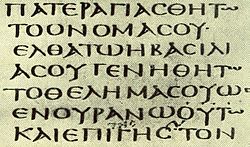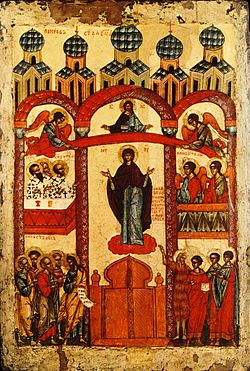Uncial is a majuscule script (written entirely in capital letters) commonly used from the 4th to 8th centuries AD by Latin and Greek scribes. Uncial letters...
17 KB (1,963 words) - 00:13, 5 July 2025
"Insular script" is used to refer to a diverse family of scripts used for different functions. At the top of the hierarchy was the Insular half-uncial (or...
10 KB (1,112 words) - 01:04, 21 June 2025
Greek diacritics (redirect from Monotonic Greek script)
Panayotakis, Nicolaos M. (1996). "A Watershed in the History of Greek Script: Abolishing the Polytonic". In Macrakis, Michael S. (ed.). Greek Letters:...
33 KB (2,700 words) - 12:41, 22 May 2025
Roman cursive Uncial script Insular script Beneventan script Visigothic script Merovingian script Archival Skills: Palaeography Types of Script, Harvard's...
3 KB (272 words) - 05:15, 1 July 2025
A New Testament uncial is a section of the New Testament in Greek or Latin majuscule letters, written on parchment or vellum. This style of writing is...
138 KB (2,542 words) - 10:01, 3 June 2025
translation, mostly of Byzantine authors. The Cyrillic script is derived from the Greek uncial script letters, augmented by ligatures and consonants from...
94 KB (5,410 words) - 12:35, 30 July 2025
cursive, uncial and half-uncial scripts, and shares many features of uncial, especially the form of the letter ⟨g⟩. Other features of the script include...
10 KB (836 words) - 16:59, 9 July 2025
Early Cyrillic alphabet (redirect from Old Cyrillic script)
Greek uncial script, augmented by ligatures and by letters from the Glagolitic alphabet for phonemes not found in Greek. The Glagolitic script was created...
39 KB (2,178 words) - 01:53, 21 July 2025
Middle Ages from New Roman Cursive writing, first as the uncial script, and later as minuscule script. The old Roman letters were retained for formal inscriptions...
39 KB (3,251 words) - 21:12, 16 July 2025
Greek alphabet (redirect from Greek script)
Slavonic; The Cyrillic script, devised in the First Bulgarian Empire based on the Greek uncial majuscule, replaced the Glagolitic script shortly afterwards...
117 KB (9,110 words) - 18:04, 1 August 2025
in the 8th century, was based on uncial and the Luxeuil type, but was also similar to half-uncial and insular script, with elements of Roman cursive....
6 KB (710 words) - 23:33, 4 July 2025
cursive script had developed that used slanted, interconnected glyphs and many ligatures. From the mid-9th century AD onwards, the uncial script was replaced...
37 KB (4,237 words) - 01:11, 7 March 2025
Alphabet (redirect from Alphabetic script)
initial script of the liturgical language Old Church Slavonic and became, together with the Greek uncial script, the basis of the Cyrillic script. Cyrillic...
58 KB (6,737 words) - 19:17, 11 July 2025
minim is the basic stroke for the letters i, m, n, and u in uncial script and later scripts deriving from it. Parts of other letters are based on minims...
4 KB (438 words) - 03:56, 27 June 2025
are written in red. There are contemporary corrections in slanting uncial script which employ a Greek syllabification similar to that used by Victor...
3 KB (383 words) - 12:36, 22 December 2020
is the script used for writing the Coptic language, the most recent development of Egyptian. The repertoire of glyphs is based on the uncial Greek alphabet...
32 KB (1,760 words) - 01:49, 2 August 2025
Letter case (redirect from Bicameral script)
needed] Greek majuscule (9th–3rd century BCE) in contrast to the Greek uncial script (3rd century BCE – 12th century CE) and the later Greek minuscule Roman...
66 KB (7,321 words) - 19:15, 21 July 2025
Biblical manuscript (section Script and other features)
Another way of dividing handwriting is between uncial script (or majuscule) and minuscule. The uncial letters were a consistent height between the baseline...
43 KB (4,516 words) - 14:08, 6 June 2025
8th century. This was replaced by Insular script, a cursive and pointed version of the half-uncial script. This was used until the end of the 12th century...
6 KB (609 words) - 11:26, 29 July 2025
Carolingian minuscule (redirect from Carolingian script)
The script is derived partly from various continental minuscule scripts ultimately descended from late Roman cursive and partly from Roman half uncial and...
14 KB (1,683 words) - 12:33, 5 July 2025
Calligraphy (category CS1 uses Chinese-language script (zh))
although inch spaces are occasionally used. This is the case with Uncial script (hence the name "litterea unciales", which roughly translates to 'inch...
58 KB (6,215 words) - 17:25, 31 July 2025
writing in general, it developed ultimately from Roman cursive via the uncial script of Late Antiquity into the Carolingian minuscule of the 9th century...
27 KB (1,769 words) - 15:44, 13 July 2025
Ukrainian alphabet (redirect from Ukrainian script)
Methodius had created the earlier Glagolitic Slavonic script. Cyrillic was based on Greek uncial script, and adopted Glagolitic letters for some sounds which...
50 KB (2,914 words) - 15:00, 29 July 2025
Angular Glagolitic (redirect from Croatian Glagolitic Script)
the 13th century secured for Angular Glagolitic the status of this Uncial script over a wide area, and although a chancery hand soon complemented it...
11 KB (1,098 words) - 14:29, 10 June 2025
new glyph variants for Ε were introduced through handwriting. In the uncial script (used for literary papyrus manuscripts in late antiquity and then in...
21 KB (2,537 words) - 03:32, 22 July 2025
(minuscule) half-uncial script of the Latin alphabet introduced by Irish Christian missionaries. This was replaced by Insular script, a cursive and pointed...
88 KB (8,088 words) - 09:01, 29 July 2025
Latin alphabet (category Latin script)
the classical forms were the uncial script, a development of the Old Roman cursive, and various so-called minuscule scripts that developed from New Roman...
19 KB (1,759 words) - 07:09, 29 July 2025
found in Oxyrhynchus were known simply as Logia Iesu. The corresponding Uncial script Greek fragments of the Gospel of Thomas, found in Oxyrhynchus are: P...
80 KB (9,332 words) - 20:03, 1 June 2025
ἰατρικῆς, romanized: Perì hylēs iatrikēs) by Pedanius Dioscorides in uncial script. It is an important and rare example of a late antique scientific text...
13 KB (1,488 words) - 02:22, 26 April 2025
the Life of Andrew the Fool, is a quire in Munich in a 10th-century uncial script. The work was also translated into Georgian and Church Slavonic. Foolishness...
3 KB (309 words) - 19:39, 28 April 2025























